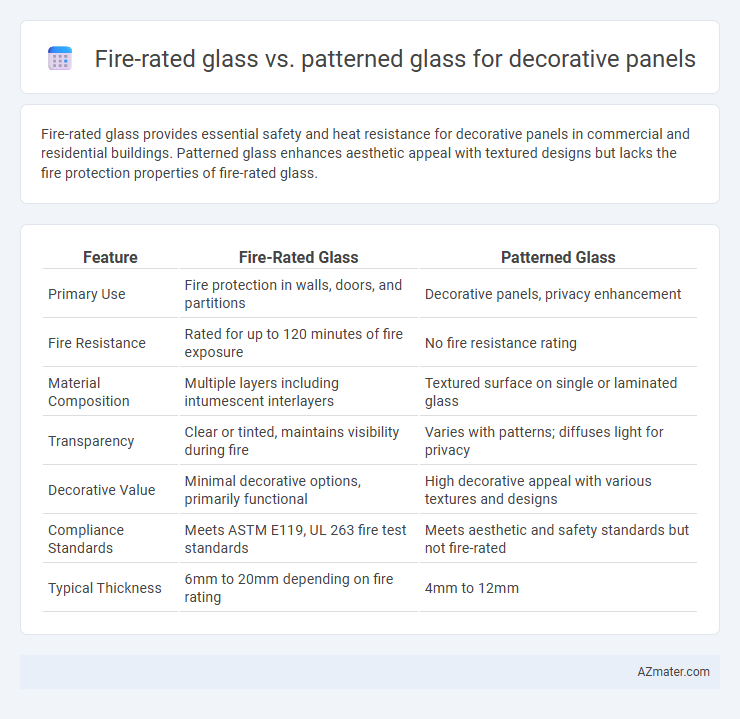Fire-rated glass provides essential safety and heat resistance for decorative panels in commercial and residential buildings. Patterned glass enhances aesthetic appeal with textured designs but lacks the fire protection properties of fire-rated glass.
Table of Comparison
| Feature | Fire-Rated Glass | Patterned Glass |
|---|---|---|
| Primary Use | Fire protection in walls, doors, and partitions | Decorative panels, privacy enhancement |
| Fire Resistance | Rated for up to 120 minutes of fire exposure | No fire resistance rating |
| Material Composition | Multiple layers including intumescent interlayers | Textured surface on single or laminated glass |
| Transparency | Clear or tinted, maintains visibility during fire | Varies with patterns; diffuses light for privacy |
| Decorative Value | Minimal decorative options, primarily functional | High decorative appeal with various textures and designs |
| Compliance Standards | Meets ASTM E119, UL 263 fire test standards | Meets aesthetic and safety standards but not fire-rated |
| Typical Thickness | 6mm to 20mm depending on fire rating | 4mm to 12mm |
Introduction to Fire-Rated and Patterned Glass
Fire-rated glass is specially engineered to withstand high temperatures and prevent the spread of fire, making it essential for safety-rated partitions and doors in commercial and residential buildings. Patterned glass, on the other hand, features textured surfaces that provide decorative appeal and privacy while allowing natural light to diffuse through interior spaces. Both types enhance aesthetic and functional qualities in decorative panels, with fire-rated glass prioritizing fire resistance and patterned glass focusing on design and light diffusion.
Key Differences Between Fire-Rated and Patterned Glass
Fire-rated glass is specially engineered to withstand high temperatures and prevent the spread of fire, meeting strict building codes and safety standards, whereas patterned glass primarily serves aesthetic purposes with textured or embossed designs that provide privacy and visual interest. Fire-rated glass typically incorporates multiple layers, such as intumescent interlayers or tempered glass, to ensure fire resistance, while patterned glass focuses on light diffusion and decorative appeal without fire protection capabilities. The key difference lies in fire-rated glass's certified safety performance versus patterned glass's emphasis on design enhancement and privacy.
Fire-Rated Glass: Properties and Benefits
Fire-rated glass offers exceptional heat resistance and integrity during fire incidents, maintaining safety by preventing the spread of flames and smoke. Designed with multiple layers, including a transparent intumescent interlayer, it provides up to 120 minutes of fire protection while ensuring visibility and light transmission. Its compliance with stringent fire safety standards makes it ideal for use in decorative panels where both aesthetics and fire safety are paramount.
Patterned Glass: Aesthetic Features and Advantages
Patterned glass offers a unique blend of aesthetics and functionality for decorative panels, featuring intricate textures that scatter light and provide privacy without compromising natural illumination. Its diverse patterns and finishes enhance interior design by adding depth and visual interest, making it ideal for partitions, doors, and wall panels. Compared to fire-rated glass, patterned glass prioritizes decorative appeal while still offering durability and ease of maintenance.
Safety and Performance Considerations
Fire-rated glass offers superior safety by providing critical fire resistance and preventing the spread of flames and smoke, making it ideal for high-risk areas in decorative panels. Patterned glass enhances aesthetic appeal and diffuses light but lacks the stringent fire performance properties needed for fire safety compliance. Choosing fire-rated glass ensures adherence to safety codes and maximizes protection, while patterned glass prioritizes design over fire performance.
Design Flexibility and Customization
Fire-rated glass offers critical safety features while allowing design flexibility with options like wired, ceramic, or tempered variations, fitting diverse architectural requirements. Patterned glass excels in customization, providing a wide array of textures and patterns that enhance aesthetics and privacy without compromising natural light. Both materials can be tailored to specific decorative panel needs, balancing safety standards with creative design possibilities.
Cost Comparison: Fire-Rated vs Patterned Glass
Fire-rated glass generally costs significantly more than patterned glass due to its specialized construction and fire-resistant certification requirements. Patterned glass, often used for decorative purposes, offers a more affordable option with varied textures and designs but lacks the high safety standards of fire-rated alternatives. Budget considerations often favor patterned glass for aesthetic enhancements, while fire-rated glass justifies its premium price through enhanced protection and regulatory compliance.
Installation Requirements and Maintenance
Fire-rated glass installation requires adherence to strict building codes and must be fitted within certified fire-rated frames to ensure compliance and safety. Patterned glass installation is more flexible, allowing for standard framing options without specific fire safety mandates. Maintenance of fire-rated glass involves regular inspections for integrity and seals, while patterned glass maintenance focuses on cleaning to preserve surface texture and prevent scratches.
Applications in Decorative Panel Projects
Fire-rated glass provides essential safety features by withstanding high temperatures and preventing smoke spread in decorative panel projects for commercial buildings, hospitals, and schools. Patterned glass enhances aesthetic appeal with varied textures and light diffusion, making it ideal for privacy screens, feature walls, and interior partitions in residential and hospitality environments. Selecting fire-rated glass meets stringent building codes and fire safety regulations, while patterned glass offers versatile design options without compromising light transmission.
Choosing the Right Glass for Decorative Panels
Fire-rated glass offers essential safety benefits by providing heat resistance and preventing the spread of flames, making it ideal for compliance with building codes in decorative panels located in high-risk areas. Patterned glass enhances aesthetic appeal through various textures and designs, creating privacy and visual interest without compromising light transmission. Choosing the right glass depends on balancing safety requirements with decorative goals, where fire-rated glass ensures protection and patterned glass contributes to style and ambiance.

Infographic: Fire-rated glass vs Patterned glass for Decorative panel
 azmater.com
azmater.com